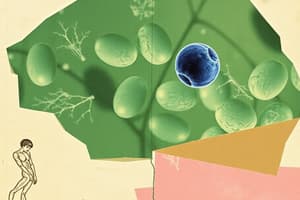Podcast
Questions and Answers
What is the primary function of the nucleus in a cell?
What is the primary function of the nucleus in a cell?
- To control what comes in and out of the cell
- To facilitate chemical reactions
- To make things happen in the cell (correct)
- To make proteins
What is the main purpose of chlorophyll in plant cells?
What is the main purpose of chlorophyll in plant cells?
- To convert light into glucose
- To facilitate photosynthesis (correct)
- To produce oxygen
- To release energy
What is the role of the cell membrane in a cell?
What is the role of the cell membrane in a cell?
- To release energy
- To control what comes in and out of the cell (correct)
- To produce proteins
- To facilitate chemical reactions
Where do ribosomes primarily function in a cell?
Where do ribosomes primarily function in a cell?
What is the byproduct of photosynthesis, aside from glucose?
What is the byproduct of photosynthesis, aside from glucose?
Flashcards are hidden until you start studying
Study Notes
- Animal and plant cells have distinct structures when viewed through a microscope.
- The nucleus is located at the center of the cell and plays a crucial role in cellular processes.
- Cytoplasm is the site of chemical reactions and contains organelles that perform various functions.
- The cell membrane surrounds the cell and regulates the movement of substances in and out.
- Energy release occurs in the mitochondria, where ribosomes are also present to produce proteins.
- Plant cells have three unique organelles: cell vacuole, chloroplasts, and chlorophyll, which are involved in photosynthesis.
- Photosynthesis is the process by which plants convert light and CO2 into glucose and O2, releasing energy in the process.
Studying That Suits You
Use AI to generate personalized quizzes and flashcards to suit your learning preferences.




